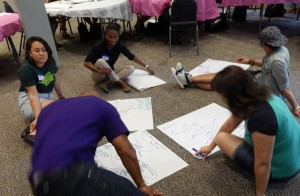This spring, Adriann Barboa and her colleagues at Strong Families New Mexico went on a five-county tour, fanning out across the state to share findings from the Breaking Barriers study they’d conducted on progress under the Affordable Care Act (ACA).
The report is part of a ten-state series by the Alliance for a Just Society.
“In all the towns we went to, many people said it was great to finally have insurance, but they didn’t know how to use it,” Barboa said.
“The Breaking Barriers report recommends using navigators to help people understand what a primary care provider is, what preventive care is, and how to get those services using their insurance,” Barboa said. “Across the five counties people pointed to that recommendation and said ‘That’s what we need.'”
Since passage of the ACA, the United States has seen a record decline in the uninsured rate. In 2013, more than 13 percent of people in the country were uninsured. By 2014, that figure had dropped to 10.4 percent.
These gains were achieved thanks to the ACA’s Medicaid expansion and subsidies for coverage through state and federal marketplaces. The new law made millions of people eligible for health coverage when they’d been shut out in the past.
But, even with these changes, it took real people to get so many new enrollees through the door – these are the navigators mentioned by Barboa.
In the first open enrollment period alone, navigators and other enrollment assisters helped more than 10 million people apply for coverage. These navigators provided information about plans, assisted people with forms, helped them submit documents, and showed them how to make their payments.
This help was – and continues to be – key to the ACA’s success, which is why the federal Department of Health and Human Services is increasing its investment in navigator programs.
We all know how apt the term “navigator” is, since the process of enrolling in health insurance is so complicated. But those complications don’t end once you’re signed up for insurance and have sent off your first premium payment. Using health insurance can be very confusing, too.
Many of us have had questions about our coverage. How do I select a doctor or other practitioner from my health plan’s list of providers? What kind of care comes free of additional costs, and when may I be charged out-of-pocket payments – and how much will those payments be? How do I find out what services or prescriptions are covered? If I’m denied a service, what are my rights to challenge that denial?
These questions are hard enough when you’ve had health insurance your whole life. It’s that much harder if you’re getting coverage for the first time. In that case, you’re entering a new world of formal terminology, provider lists, and paperwork.
That’s why navigator-type programs should be there for us after we enroll, too.
Without an effort to make sure coverage translates into care, we run the risk of missing out on the promise of health reform – which, we should remember, is about transforming our health sector so people can get the care they need. Enrolling all those millions of formerly uninsured people is just the first step.
As the Alliance for a Just Society’s recent Breaking Barriers reports show, many people – especially people of color and low-income people – still aren’t getting into the doctor’s office even after they have coverage.
Some community-based organizations provide good models for how an integrated assistance program can help people move into coverage and then turn that coverage into care.
The Community Service Society of New York (CSSNY) provides one such model. Drawing on funding from New York State, CSSNY has established an innovative coverage-to-care approach – using both a navigator network and a community health advocates program – that helps people obtain coverage and put their coverage to use.
A New Yorker needing help can call CSSNY’s toll-free helpline, where advocates connect people to enrollment assistance, answer questions about coverage, or help troubleshoot insurance issues (such as coverage denials or billing problems). Using a hub-and-spoke structure, CSSNY also works with a broad, statewide network of community group and small business groups, offering help in almost 200 languages.
We need more programs like this one if we hope to truly transform our health care system and make it work for everyone. We need to make sure a person’s insurance card is worth much more than the plastic it’s printed on. Good coverage-to-care navigator programs are key to achieving that goal.
